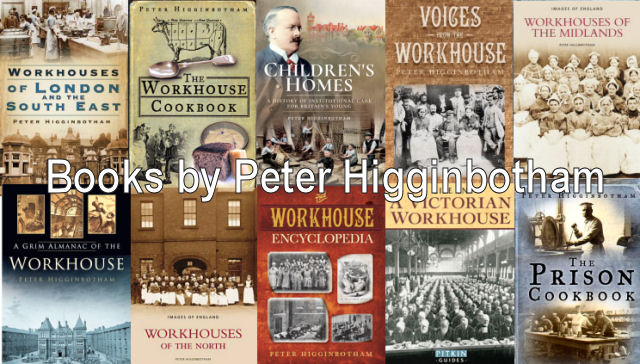London Workhouse Burial Grounds
In a large number of the London parishes it was necessary to have "poor grounds," i.e., graveyards where bodies could be interred at a trifling cost or entirely at the cost of the parish; for, notwithstanding the great dislike of the poor to "a pauper's funeral," and the efforts they will make to avoid it, there always have been cases in which no other sort of funeral can be arranged. Some of the "poor grounds" were attached to the workhouses, others were merely a part of the parish churchyards, while others again were older additional burial-grounds secured by the parishes before the days of workhouses.
The workhouse of St. Andrew's, Holborn, was in Shoe Lane, and in the adjoining graveyard the unfortunate young genius, Chatterton, was buried. This ground gave way to the Farringdon Market, which, in its turn, has been supplanted by a new street called Farringdon Avenue. The workhouse ground of St. Sepulchre's, Holborn, together with another additional graveyard belonging to the parish, was in Durham Yard, and the sites of both of them have disappeared in the goods depot of the Great Northern Railway. The burial-grounds by the workhouses of Shoreditch, St. Paul's, Covent Garden, and St. Giles (in Short's Gardens) have also disappeared; so also has the one allotted to the use of St. James' Workhouse in Poland Street, which was a part of the old pest-field, although a remnant of the pest-field exists still as the workhouse garden. The original Whitechapel Workhouse was built in 1768 on a burial-ground, and then a plot of land immediately to the north was set aside for a poor ground, and consecrated in 1796. This in turn became the playground of the Davenant Schools, one of which (facing St. Mary's Street) was built in it. A recent addition to the other school has also encroached on the burial-ground. In 1832 196 cholera cases were interred in an adjoining piece of ground, which was probably what is now used as a stoneyard, and is full of carts. The workhouse graveyard, belonging to St. Clement Danes, was in Portugal Street. The workhouse itself was re-adapted and re-opened as King's College Hospital, but the burial-ground was used until its condition was so loathsome, and the burning of coffins and mutilation of bodies was of such every-day occurrence, that it must have been one of the very worst of such places in London. It is now the garden or courtyard and approach, between the hospital and Portugal Street. The burial-ground attached to the Workhouse of St. Saviour's, Southwark (which may have been the old Baptist burial ground in Bandy Leg Walk which existed in 1729) has a curious history. The workhouse was supplanted by Winchester House, the palace of the bishops when South London was in their diocese, the old Winchester House, nearer the river, having been destroyed. This in time became a hat manufactory, the burial-ground remaining as a garden situated between the building and Southwark Bridge Road. Finally, the site was secured by the Metropolitan Board of Works for the Central Fire Brigade Station, and what is now left of the burial-ground is the garden or courtyard between the new buildings which face the road and the old house behind them. If the paupers and the bishops and the factory hands did not succeed in frightening away the ghosts of the departed, they must have a sorry time of it now when the call-bells from all parts of London bring out the engines and the men who fight the flames.
Of the parochial "poor grounds" not adjoining workhouses a few are worth noticing. St. Saviour's, Southwark, in addition to the workhouse ground, the College or Almshouse ground, and the churchyard itself, which was from time to time added to, curtailed and used for markets, possessed still another graveyard, the famous Cross Bones ground in Union Street, referred to by Stow as having been made "far from the Parish Church," for the interment of the low women who frequented the neighbourhood. It subsequently became the parish poor-ground, and after having been in use, and very much over-crowded, for upwards of 200 years, it was closed by order in Council dated October 24, 1853. In a report upon the state of this ground the previous year, it is stated that "it is crowded with dead, and many fragments of undecayed bones, some even entire, are mixed up with the earth of the mounds over the and it "can be considered only as a convenient place for getting rid of the dead, but it bears no marks of ever having been set apart as a place of Christian The Cross Bones ground passed out of the hands of the rector several years ago and was sold as a building site, but building operations were opposed and stopped. Schools were erected in it before it was closed for burials. It has been the subject of much litigation, and it now stands vacant, waiting for some one to purchase it as a playground, and used in the meantime as the site for fairs, merry-go-rounds, and cheap shows.
The "poor ground" for the parish of St. George the Martyr, Southwark, is a square plot of land, now a little public garden, in Tabard Street. It was originally the burial-ground of the adjoining Lock Hospital before that building was removed in 1809 to Knightsbridge, whence, later on, it was again removed to Harrow Road. It is said by some that the little cemetery was even older than the hospital, and may have been used for interments during no less than eight centuries. The Cripplegate "poor ground," or the "upper churchyard of St. Giles," was in Bear and Ragged Staff Yard (afterwards called Warwick Place) out of Whitecross Street, and was first used in 1636. 185 It was very much over-crowded, so much so that it was more than once shut up for a few years as full, but always re-opened again. A part of the site is now occupied by the northern half of the church of St. Mary, Charterhouse, and by its mission-house, there being only a tar-paved pathway round these buildings to represent the rest of the ground. The church was built in 1864. There are human remains within six inches of the surface of the ground, several having been dug up and put in a vault which is under the mission house, and the entrance to which is closed with a very large flat stone, bearing the date of 1865. The mission-house is giving way already, and it has large cracks in it, for a vault of this kind is not a good foundation.
The parish of St. James', Clerkenwell, had a very small "poor in Ray Street, which was bought in 1755 for £340, and was consecrated eight years later. It was 800 square yards in area, and was approached through a private house occupied by a butcher, "who had his slaughter-house and stable at the back, and immediately adjoining the burial-ground." In about the year 1824 it was found that several bodies had been exhumed and placed in the stable; this caused a scandal in the neighbourhood, and the man and his business were ruined. When Farringdon Street and the Metropolitan Railway were made, the site of the ground in Ray Street, together with Ray Street itself, entirely disappeared; and the "sleepers of the railway are laid over the sleepers in death." The burial-ground had already been done away with, the Clerkenwell Commissioners, according to Pinks, having taken it for public improvements, when they collected the remains into one spot and erected a plain mausoleum over them.
Unless otherwise indicated, this page () is copyright Peter Higginbotham. Contents may not be reproduced without permission.



